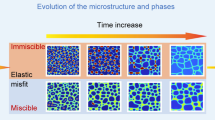Abstract
Magnetic shape memory (MSM) alloys, which transform martensitically below the Curie temperature in the ferromagnetic (FM) state, represent a new class of actuators. In Ni2MnGa, unusually large magnetic field-induced strains of about 10% have been observed. This effect is related to a high mobility of martensitic twin boundaries in connection with a large magneto-crystalline anisotropy. MSM materials exist in a variety of different martensitic structures depending on temperature and compositions. We investigate the energetics of L10 phase twin boundary motion quasi-statically with ab initio methods and relate the results to calculations of the magneto-crystalline anisotropy energy. Our results indicate that for the L10 structure the energy needed for a coherent shift of a twin boundary may be too large to be overcome solely by magnetic field-induced strains.





Similar content being viewed by others
References
Ullakko K, Huang JK, Kantner C, O’Handley RC, Kokorin VV (1996) Appl Phys Lett 69:1966
Sozinov A, Likhachev AA, Lanska N, Ullakko K (2002) Appl Phys Lett 80:1746
Söderberg O, Ge Y, Sozinov A, Hannula S-P, Lindroos VV (2005) Smart Mater Struct 14:223
Entel P, Buchelnikov VD, Khovailo VV, Zayak AT, Adeagbo WA, Gruner ME, Herper HC, Wassermann EF (2006) J Phys D: Appl Phys 39:865
Krenke T, Acet M, Wassermann EF, Moya X, Mañosa L, Planes A (2006) Phys Rev B 73:174413
Krenke T, Duman E, Acet M, Wassermann EF, Moya X, Mañosa L, Planes A, Suard E, Ouladdiaf B (2007) Phys Rev B 75:104414
Chernenko V, Segui C, Cesari E, Pons J, Kokorin V (1998) Phys Rev B 57:2659
Kresse G, Furthmüller J (1996) Phys Rev B 54:11169
Kresse G, Joubert D (1999) Phys Rev B 59:1758
Perdew JP, Burke K, Ernzerhoff M (1996) Phys Rev Lett 77:3865
Koepernik K, Eschrig H (1999) Phys Rev B 59:1743
Opahle I, Koepernik K, Eschrig H (1999) Phys Rev B 60:14035
Eschrig H, Richter M, Opahle I (2004) In: Schwerdtfeger P (ed) Relativistic electronic structure theory, Part II. Applications, Vol. 14 of theoretical and computational chemistry, Elsevier, pp 723–776
Perdew JP, Wang Y (1992) Phys Rev B 45:13244
Enkovaara J, Ayuela A, Nordström L, Nieminen RM (2002) Phys Rev B 65:134422
Ayuela A, Enkovaara J, Nieminen RM (2002) J Phys: Condens Matter 14:5325
Zayak A, Entel P, Hafner J (2003) J Phys IV 112:985
James RD, Hane KF (2000) Acta Mater 48:197
Bhattacharya K (2003) Microstructure of martensite—why it forms and how it gives rise to the shape-memory effect. Oxford University Press, Oxford
Pitteri M, Zanzotto G (2003) Continuum models for phase transitions and twinning in crystals. Chapman & Hall/CRC, Boca Raton
Ball JM, James RD (1987) Arch Rat Mech Anal 100:13
Bain EC (1926) Trans AIME 70:25
Pond RC, Celotto S (2003) Int Mater Rev 48:225
Kakeshita T, Fukuda T, Takeuchi T (2006) Mater Sci Eng A 438–440:12
Okamoto N, Fukuda T, Kakeshita T, Takeuchi T (2006) Mater Sci Eng A 438–440:948
Kakeshita T, Fukuda T (2006) Int J Appl Electrom 23:45
Kokalj A (2003) Comp Mater Sci 28:155; https://doi.org/www.xcrysden.org
Acknowledgements
We would like to thank U. K. Rößler for helpful discussions and a careful proofreading of the manuscript. Large parts of the calculations were performed on the IBM Blue Gene/L supercomputer of the John von Neumann Institute for Computing at Forschungszentrum Jülich, Germany. We thank the local staff for their support and Dr Pascal Vezolle of IBM for his efforts in optimizing the VASP binary for the Blue Gene/L architecture. The atomistic visualizations in Fig. 5 were prepared using XCrySDen [28]. Financial support was granted by the Deutsche Forschungsgemeinschaft through the Priority Programme SPP1239, Change of microstructure and shape of solid materials by external magnetic fields.
Author information
Authors and Affiliations
Corresponding author
Rights and permissions
About this article
Cite this article
Gruner, M.E., Entel, P., Opahle, I. et al. Ab initio investigation of twin boundary motion in the magnetic shape memory Heusler alloy Ni2MnGa. J Mater Sci 43, 3825–3831 (2008). https://doi.org/10.1007/s10853-007-2291-5
Received:
Accepted:
Published:
Issue Date:
DOI: https://doi.org/10.1007/s10853-007-2291-5




